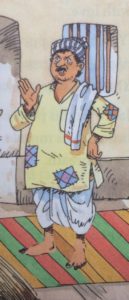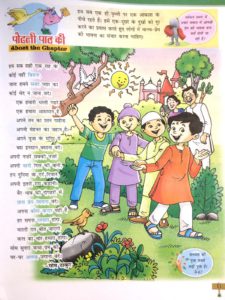Sonali Jindal took an MA in Comparative Literature (Asia/Africa) at SOAS, and is currently working at a publishing house in Delhi.
A TEXBOOK EXAMPLE – How English schools shape views of Hindi Literature
SOAS was where I first developed an appreciation for Hindi Literature. Reading Hindi stories with themes such as loneliness and alienation in urban landscapes, generation gap conflicts, a man travelling the world, discussing art, or simply having a beer with friends, was a novel experience. While these things are common enough in life and literature, for some reason I had trouble imagining these in my own mother tongue! I realised that my exposure to Hindi literature, limited to school textbooks, had unwittingly created in my mind an image of Hindi literature as exclusively nationalistic. This insight made me want to find out whether a fundamental difference exists in the treatment of Hindi and English Literature in English-medium schools in contemporary India.
In order to do so, I analysed and compared the grade-7 textbooks (for 12-year olds) of Hindi and English literature of two major educational boards in India, the Council for the Indian School Certificate Examination (CISCE) and the Central Board of Secondary Education (CBSE).

An Indian Farmer

An English Chimney Sweeper
As a matter of fact, for urban, middle class and upper-middle class students in English-medium schools, literatures in both English and Hindi lack relatable content. English textbooks are dominated by British and American authors. The CISCE text, for example, is full of stories and poems describing scenes from 19th century London. In fact, only 3 out of its 23 chapters can be attributed to Indian authors. Of these, one tells the tale of an impoverished tenant farmer and another is about a poor migrant working in a small eatery in Mumbai. Though the setting of these two stories differs vastly with regards to both time and place, yet the illustrations accompanying both are strikingly similar, showing characters dressed in patched-over kurtas. The text and illustrations implicitly create a correlation between India and poverty: not just because two out of the three Indian-authored stories revolve around penniless protagonists, but also because the few illustrations of lower-class Englishmen that do occur fail to accurately portray their poverty: the text’s image of chimney sweepers, for example, is a far cry from their real-life unkempt, soot-covered appearance.
Furthermore, the Indian stories are not taken as opportunities to understand or engage with their characters or issues. Follow-up questions rarely encourage creativity or empathy. In the case of the story about the migrant worker in Mumbai, one exercise affirms that the story’s description of the poor eatery “may not increase [the reader’s] appetite”, and encourages students to write about a “smart” restaurant they have visited. The assumption of the students’ class is not accidental – someone who can afford a textbook priced at Rs 385 (over £4) must necessarily belong to an affluent middle class household. Evidently, the textbook works to create a distance between the students and ‘poor’ Indians, homogenising them as the ‘Other’.
The CBSE textbook has similarly low percentage of Indian chapters, though it makes a greater effort to connect the text with the lives of students. Questions encourage students to give their opinions on characters or conduct a survey relating to the content of the story. Interestingly, the CBSE book also encourages students’ bilingualism, with exercises asking them to name things in their mother tongue. These efforts clearly attempt to accomplish the textbook’s self-proclaimed goal of bridging the ‘gap’ between the students’ school and home lives.
As the extensive grammar exercises show, however, learning the English language continues to remain the main goal for both the CISCE and the CBSE texts. Only, the CISCE text lays emphasis on exposing students to different literary genres as well as poetic devices, whereas the CBSE textbook appears to pay much less attention to the development of literary tastes.
While the alienation experienced by students from ex-colonies when studying English literature has been previously studied, there has been no study of the impact of Hindi literature on modern English-speaking students.
Hindi textbooks in the colonial period, sought to instil “feelings of duty towards the nation (deś-sevā) and a common national identity.” Contemporary CBSE and CISCE Hindi textbooks continue to view Hindi literature as fulfilling a social and nationalist function, as the dominance of didactic works and comparative lack of ‘fun’ literature show. The belief that the primary purpose of Hindi literature is to instil moral values is a conscious one: a CISCE Hindi teacher I interviewed said that her school actively sought out Hindi textbooks with moral values and patriotism. Another interviewee teaching in a CBSE school confirmed this stance and went on to cite the discontinuation of ‘Moral Science’ classes in her school as a reason why Hindi must include moral values.
The colourful CISCE textbook includes overt displays of patriotism: a picture of four boys who visibly belong to different religions (Hindu, Muslim, Sikh and Christian) is displayed prominently right in the beginning of the book, and then repeated several times throughout, emphasising the ideal secular nation. There are also multiple images of the Indian flag throughout the textbook. The CBSE textbook’s nationalism is comparatively muted, with fewer explicitly patriotic chapters. Crucially, it departs from the standardised Hindi that was used in colonial textbooks and instead encourages the use of colloquial Hindi and Urdu words.
As far as Hindi vocabulary is concerned, the CISCE text provides exhaustive glossaries, explaining difficult words in both simple Hindi as well as English—the implication being that the Hindi education is a difficult one, and that students may be more familiar with simple English equivalents. The CBSE text on the other hand does not rely on English, and gives fewer explanations, thus setting a higher benchmark for Hindi.
The content of Hindi literature textbooks has a long-lasting impact on students. In interviews, ex-students of both CISCE and CBSE remembered Hindi literature in school as ‘boring’, ‘moralistic’ and ‘irrelevant’. Crucially, like myself these students only encountered Hindi literature that was found in the textbooks. Institutional factors, such as lack of Hindi books in the library, greater focus on English reading outside class, and in some schools the compulsory use of English even for personal communication, prevented students from exploring Hindi literature beyond the textbooks. As a result, their leisure reading occurred entirely in English, and their only perception of Hindi literature remained of it being overly patriotic.

Secular Ideal in CISCE textbook
Clearly, language instruction in English-medium schools fails to impart any literary taste for Hindi (one might even say they impart a distaste for it) while encouraging English reading. The power that schools have to inculcate preference for literature in one language over another is something that still needs to be acknowledged and understood, especially by people inadvertently affected by it.
BIBLIOGRAPHY
Horsburgh, Nicholas, New Oxford Modern English Coursebook Class 7, Revised edition (Oxford University Press, 2016)
NCERT, Honey Comb – Textbook in English for Class – 7 – 753, 2013 edition (National Council of Education Research and Training, 2014)
—.——, Vasant Bhaag – 2 Textbook in Hindi for Class – 7 – 750 (National Council of Education Research and Training, 2015)
Orsini, Francesca, The Hindi Public Sphere, 1920-1940 : Language and Literature in the Age of Nationalism / (New Delhi : Oxford University Press, 2002)
Roli: Hindi Pathmala (G. Ram Books (P.) Ltd.)


Very good naration of Indian School trxt books. Bold and true. Kudos to writer. Continue the good work.
Happy to read the truth of Indian school text books. Kudos to writer. Continue the good work.